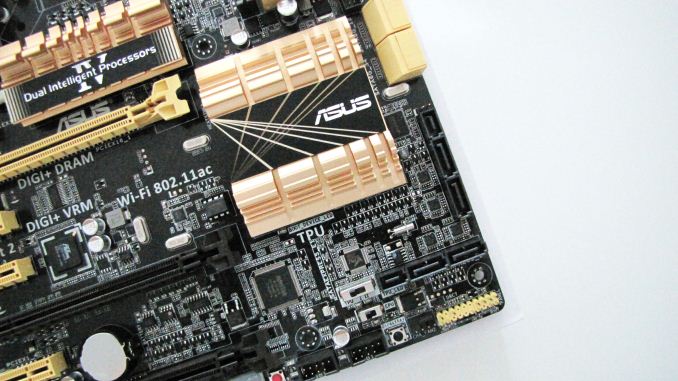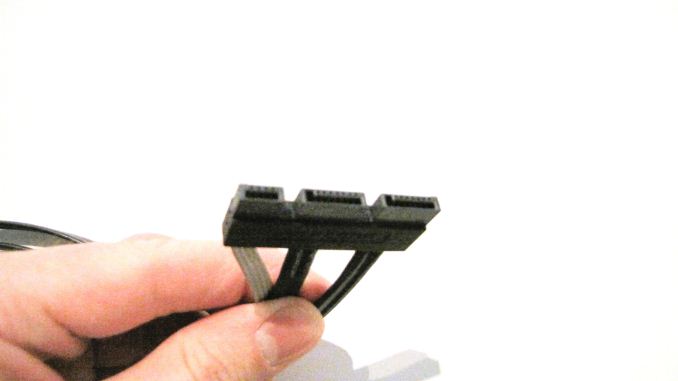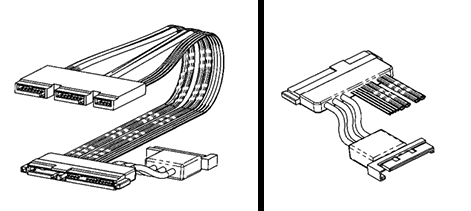Testing SATA Express And Why We Need Faster SSDs
by Kristian Vättö on March 13, 2014 7:00 AM EST- Posted in
- Storage
- SSDs
- Asus
- SATA
- SATA Express
What Is SATA Express?
Officially SATA Express (SATAe from now on) is part of the SATA 3.2 standard. It's not a new command or signaling protocol but merely a specification for a connector that combines both traditional SATA and PCIe signals into one simple connector. As a result SATAe is fully compatible with all existing SATA drives and cables and the only real difference is that the same connector (although not the same SATA cable) can be used with PCIe SSDs.
As SATAe is just a different connector for PCIe, it supports both the PCIe 2.0 and 3.0 standards. I believe most solutions will rely on PCH PCIe lanes for SATAe (like the ASUS board we have), so until Intel upgrades the PCH PCIe to 3.0, SATAe will be limited to ~780MB/s. It's of course possible for motherboard OEMs to route the PCIe for SATAe from the CPU, enabling 3.0 speeds and up to ~1560MB/s of bandwidth, but obviously the PCIe interface of the SSD needs to be 3.0 as well. The SandForce, Marvell, and Samsung designs are all 2.0 but at least OCZ is working on a 3.0 controller that is scheduled for next year.
The board ASUS sent us has two SATAe ports as you can see in the image above. This is a similar port that you should find in a final product once SATAe starts shipping. Notice that the motherboard connector is basically just two SATA ports and a small additional connector—the SATA ports work normally when using a standard SATA cable. It's only when the connector meets the special SATAe cable that PCIe magic starts happening.
ASUS mentioned that the cable is not a final design and may change before retail availability. I suspect we'll see one larger cable instead of three separate ones for esthetic and cable management reasons. As there are no SATAe drives available yet, our cable has the same connector on both ends and the connection to a PCIe drive is provided with the help of a separate SATAe daughterboard. In the final design the other end of the cable will be similar to the current SATA layout (data+power), so it will plug straight into a drive.
That looks like the female part to the SATA connector in your SSD, doesn't it?
Unlike regular PCIe, SATAe does not provide power. This was a surprise for me because I expected SATAe to fully comply with the PCIe spec, which provides up to 25W for x2 and x4 devices. I'm guessing the cable assembly would have become too expensive with the inclusion of power and not all SATA-IO members are happy even with the current SATAe pricing (about $1 in bulk per cable compared to $0.30 for normal SATA cables). As a result, SATAe drives will still source their power straight from the power supply. The SATAe connector is already quite large (about the same size as SATA data + power), so instead of a separate power connector we'll likely see something that looks like this:
In other words, the SATAe cable has a power input, which can be either 15-pin SATA or molex depending on the vendor. The above is just SATA-IO's example/suggestion—they haven't actually made any standard for the power implementation and hence we may see some creative workarounds from OEMs.















131 Comments
View All Comments
phoenix_rizzen - Friday, March 14, 2014 - link
I was thinking more for the situation where you replace the current SATA ports on a mobo with PCIe x2 slots.So you go from cabling your drives to the SATA ports to cabling your drives to the PCIe ports. Without using up any of the slots on the back of the board/case.
SirKnobsworth - Saturday, March 15, 2014 - link
If you don't want to use actual PCIe slots then have M.2 sockets on the motherboard. There's no reason to have another cabling standard.phoenix_rizzen - Monday, March 17, 2014 - link
That works too, and is something I mention in another comment above.This cable and connector doesn't make sense, any way you look at it.
Kracer - Thursday, March 13, 2014 - link
Are you able to run any sort of PCI-Device over SATAe (GPUs, capture cards, etc.)?Two lanes are not enough for GPU use but it would open up much more possibilities.
Are you able to use it as a boot device?
The Von Matrices - Thursday, March 13, 2014 - link
I understand the desire for faster SSDs, but I still fail to see the purpose of SATA express over competing standards. There's nothing compelling about it over the competition.M.2 already provides the PCIe x2 interface and bandwidth (albeit without the ability to use cables).
Motherboards that support PCIe 3.0 SATA Express without either a high priced PCIe switch or compromising discrete graphics functionality are one to two years away.
SF3700 is PCIe 2.0 x4, meaning that SATA express can only use half its performance and PCIe x4 cards will still be the enthusiast solution.
NVMe can already be implemented on other standards.
The cables are bulky, which is unusual considering that SAS at 12Gb/s (which is available) is using the same small connectors as 6Gb/s.
SirKnobsworth - Thursday, March 13, 2014 - link
M.2 provides a PCIe x4 interface in certain configurations. I think the SATAe specification has the provision for adding another two lanes at some point in the future but that's not going to happen for a long time.Kevin G - Thursday, March 13, 2014 - link
SATAe and NVMe is fast and important for expandable IO. However I believe that it will be secondary over the long term. I fathom that the NAND controller will simply move on-die for mobile SoCs. The reason for this will be power savings, lower physical area and performance reasons. Some of the NVMe software stack will be used here but things like lane limitations will be entirely by-passed since it all on die. Bandwidth would scale by the number of NAND channels. Power savings will come from a reduction in an external component (SATAe controller and/or external chipset) and the ability to integrate with the SoC's native power management controller. Desktop versions of these chips will put the NAND on a DIMM form factor for expansion.The SATAe + NVMe will be huge in the server market though. Here RAS plays a bigger role. Features like redundancy and hotswap are important, even with more reliable SSD's compared to their hard drive predecessors. I eventually see a backplane version of a connector like mSATA or M.2 replacing 2.5" hard drives/SSD in servers. This would be great for 1U servers as they would no longer be limited to 10 drives. The depth required on a 1U server wouldn't be as much either. PCIe NVMe cards will fill the same niche today: radically high storage bandwidth at minimal latencies.
One other thing worth pointing out is that since Thunderbolt encapsulates PCIe, using external SATAe storage at full speed becomes a possibility. Working in NVMe mode is conceptually possible over Thunderbolt too.
xdrol - Thursday, March 13, 2014 - link
Parallel ATA is back, just look at the cable size..JDG1980 - Thursday, March 13, 2014 - link
A ribbon cable *plus* a Molex? Oh, goody. This looks like a massive step backward.sheh - Thursday, March 13, 2014 - link
Who doesn't love them flatcables?